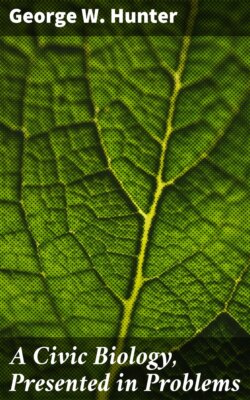Читать книгу A Civic Biology, Presented in Problems - George W. Hunter - Страница 7
На сайте Литреса книга снята с продажи.
ОглавлениеA natural barrier on a stream. No trout would be found above this fall. Why not?
A goldfish placed in a small glass jar with no food or no green water plants soon seeks the surface of the water, and if the water is not changed frequently so as to supply air the fish will die. Again the artificial environment lacks something that the fish needs. Each plant and animal is limited to a certain environment because of certain individual needs which make the surroundings fit for it to live in.
Changes in Environment.—Most plants and animals do not change their environment. Trees, green plants of all kinds, and some animals remain fixed in one spot practically all their lives. Certain tiny plants and most animals move from place to place, either in air, water, on the earth or in the earth, but they maintain relatively the same conditions in environment. Birds are perhaps the most striking exception, for some may fly thousands of miles from their summer homes to winter in the south. Other animals, too, migrate from place to place, but not usually where there are great changes in the surroundings. A high mountain chain with intense cold at the upper altitudes would be a barrier over which, for example, a bear, a deer, or a snail could not travel. Fish like trout will migrate up a stream until they come to a fall too high for them to jump. There they must stop because their environment limits them.
A new apartment house, with out-of-door sleeping porch.
Man in his Environment.—Man, while he is like other animals in requiring heat, light, water, and food, differs from them in that he has come to live in a more or less artificial environment. Men who lived on the earth thousands of year ago did not wear clothes or have elaborate homes of wood or brick or stone. They did not use fire, nor did they eat cooked foods. In short, by slow degrees, civilized man has come to live in a changed environment from that of other animals. The living together of men in communities has caused certain needs to develop. Many things can be supplied in common, as water, milk, foods. Wastes of all kinds have to be disposed of in a town or city. Houses have come to be placed close together, or piled on top of each other, as in the modern apartment. Fields and trees, all outdoor life, has practically disappeared. Man has come to live in an artificial environment.
Care and Improvement of One's Environment.—Man can modify or change his surroundings by making this artificial environment favorable to live in. He may heat his dwellings in winter and cool them in summer so as to maintain a moderate and nearly constant temperature. He may see that his dwellings have windows so as to let light and air pass in and out. He may have light at night and shade by day from intense light. He may have a system of pure water supply and may see that drains or sewers carry away his wastes. He may see to it that people ill with "catching" or infectious diseases are isolated or quarantined from others. This care of the artificial environment is known as sanitation, while the care of the individual for himself within the environment is known as hygiene. It will be the chief end of this book to show girls and boys how they may become good citizens through the proper control of personal hygiene and sanitation.
Reference Books
elementary
Hunter, Laboratory Problems in Civic Biology. American Book Company.
Hough and Sedgwick, Elements of Hygiene and Sanitation. Ginn and Company.
Jordan and Kellogg, Animal Life. Appleton.
Sharpe, A Laboratory Manual for the Solution of Problems in Biology, p. 95. American Book Company.
Tolman, Hygiene for the Worker. American Book Company.
advanced
Allen, Civics and Health. Ginn and Company.
